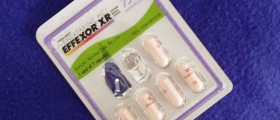Loading...
Extremely interested!! I have been trying to so the same!!
Loading...
Loading...
I am currently in withdrawl from effexor xr 300mg daily for 6+ years. I need info. this drug should be banned! I would love to help this case in any way I can.
***this post is edited by moderator *** *** private e-mails not allowed*** Please read our Terms of Use
Loading...
Loading...
Effexor has cheated me out of being able to have control over a drug, the right to age naturally, and has robbed me of a fully functional brain. It is like Effexor is holding my brain hostage: Buy this product or you will not be able to function. What an evil drug manufacturer--to put so many into jeopardy to acquire more wealth!
Loading...
You're the first person I have come across with the skin burning issue. I've been quit for almost three years now and STILL suffer with this skin burning....from my neck clear down to my toes....it's AWFUL!. Have other painful complaints too but this skin burning has got to be the worst of my complaints. It hurts to shower, to wear clothes, to be touched.....
Loading...
I SO GET where you're coming from! Where did you find the information about what it's done to your neurotransmitters and the homeostasis process. I'd like to learn more. Trying desperately to find answers.....
Loading...
Jennifer. Ohio. Have been on 150 mg Effexor for 15 plus years and recently lowered to 75 mg. It has caused me so many issues, withdrawal etc. Very interested in lawsuit.
***this post is edited by moderator *** *** private e-mails not allowed*** Please read our Terms of Use
Loading...
ANYONES HEAD feel like Razorblades from this med???? Did good for 10 years until this started to happen..ANYONE???
Loading...
Loading...
This is a paper and a request for legal help I submitted back in 2006. There are many references at the end. Keep fighting for justice!--Melody Depression or Antidepressant There is no truth in advertising at least not where drug companies are concerned. The FDA continues to approve psychoactive drugs on flimsy or fraudulent laboratory studies, and does nothing until a few lawyers sue on behalf of ruined patients and their families. Physicians are given limited information, by the drug company’s sales representatives, which they then rely on to write prescriptions. Millions of patients have become caught in the nightmare of antidepressant toxicity, withdrawal, and are left with permanent brain damage. Inherent dangers come with the SSRI and SNRI drugs, which may make the symptoms of depressive disorders left unmedicated safer than taking one of the usual eleven prescribed drugs. Trade names for selective serotonin reuptake inhibitor drugs are: Paxil, Zoloft, Prozac, Celexa, Lexapro, Luvox. Trade names for serotonin and noradrenalin reuptake inhibitor drugs are:Effexor, Cymbalta, Serzone. Wellbutrin boosts dopamine and Remeron boosts serotonin and noradrenalin but in a very different way from the above named drugs. During 2004, the FDA warned that any of these eleven drugs may increase patient suicides as a reaction to withdrawal. Serotonin is produced in the brain by first converting tryptophan (serotonergic neurons produce the enzyme tryptophan hydroxylase which converts tryptophan into 5-hydroxytryptophan or 5-HTP) into 5-HTP and then into 5-HT with the help of AADC (aromatic amino acid decarboxylase). Serotonergic neurons have a protein called 5-HT transporter that quickly reuptakes 5-HT. SSRI drugs slow 5-HT reuptake from the synaptic cleft. Serotonergic neurons, in the brain, send out 5-HT fibers to practically all of the forebrain and there are 15 5-HT receptor subtypes presently known. The Catecholamines ( dopamine {DA}, norepinephrine {NE}, and epinephrine {EPI}) work much like the serotonin under going biochemical steps and then are transferred to synaptic vesicles ( these neurons use a vesicular monoamine transporter protein {VMAT2} to move transmitter molecules). It is estimated that 20 million people are taking these drugs and between 40% and 74% of them will experience withdrawal symptoms, several million of which will be severe. Withdrawal from SNRI drugs is hell. I have been taking Effexor for nearly eleven years, three of them I was prescribed 550 mg. a day; well beyond FDA guidelines for safety. It took two years to get it back down to 150 mg. per day. There are millions of people held hostage by pharmaceutical companies, forced to pay out hundreds of dollars each month just to function, no longer afflicted by the original depressive disorder. Class action suits against pharmaceutical companies are hard to win because they have endless financial resources. If one of these drugs has an immediate and disastrous affect resulting in violent suicide or homicides then one might be able to prove a case. At this time it seems impossible to make pharmaceutical companies accountable for the devastation withdrawal has on lives. There is no exaggeration regarding Wyet’s reckless greed as you can read the charges pending at the end of this paper. Occasionally, I contact a law firm that is engaged in litigation with Wyet. Below is such an example. Dear Ms. McCarthy- Thank you for your e-mail. I’m so sorry to hear about what you have been through on Effexor. Our firm has been handling SSRI induced suicide and homicide cases for many years. We know there are so many people out there, like you, who have been harmed by these drugs. It is maddening. Taking on a giant pharmaceutical company is a difficult task. The companies have endless resources to defend against these cases. Most of our cases involve people who have taken the medication for a short period of time and had an immediate adverse reaction resulting in death. In our experience, it is too difficult to litigate cases where the individual has been taking Effexor for as long as you have. Therefore, we would not recommend litigation in your case. I would encourage you to get a second opinion. Others might see the issue differently. You might visit the website www.drugawareness.org as a source of information and support. They may be able to point you in the right direction for legal and/or medical advice. You also might try reading the book “The Antidepressant Solution” written by Dr. Joseph Glenmullen. He is an expert in this field and his book would be a great resource for you and your doctor in helping you get off Effexor. Finally, I encourage you to report your experiences to the FDA at http://www.fda.gov/medwatch/report/consumer/consumer.htm. They need to know about the dangers of these drugs. Good luck! Gina Vickery Ross, LCSW Case Investigator for Vickery & Waldner, LLP Subject: submitcase.htm In 1000 characters or less, please describe your case with specificity. If death or injury involved, please include either the date of death or the date of incident. I have been taking effexor for about eleven years. I required hospital care after an attempted suicide when my dosage was increased. Effexor was pivatol in allowing an out of control marriage to ruin me financially. I can not get off effexor. I get so very sick. It appears that effexor has permanently altered ( depleated) my neurotransmitter receptors. I had no clue something like this could happen. In one sentence, state what you think the potential defendant did wrong: Wyet had to know that effexor possed risks for chemical dependency, bizzar side effects, and they misled physicians and patients regarding the long term dangers and continued hardships caused by a very expensive drug. How did you find our website? Other If other, please explain: Rosemary Pinto, Philadelphia, If search engine, which one?: Thank you for contacting JusticeSeekers. It is our firm's policy to have one of the partners review and, where appropriate, respond to all incoming, unsolicited e-mail to our website. Typically, this response should come to you within one to two business days. Joseph Glenmullen, M.D. is clinical professor in psychiatry at Harvard Medical School, on the staff of Harvard University Health Services, and has a private practice in Havard Square. He worked very hard to warn physicians about the dangers of antidepressants with his first book Prozac Backlash for which he received the 2001 Achievement Award from the American Academy for the Advancement of Medicine. During the spring of 2004 he testified before the FDA about the dangers of these drugs. His testimony was so informative and persuasive the FDA demanded black box warnings placed on all these drugs. The Antidepressant Solution is a main reference for this paper. Psychopharmacology is the study of drug-induced changes in mood, thinking, and behavior. Prescription psychoactive drugs, illegal- recreational drugs, over the counter drugs, herbals, and even diet if designed to elicit changes in mood, are parts of psychopharmacology. An interesting example of diet affecting the brain is found in the synthesis of serotonin (5-HT). Tryptophan is an amino acid protein that must compete with larger natural amino acids to cross the blood brain barrier. It would make sense to assume that a high protein meal would help to boost tryptophan levels in the brain. In fact, the opposite is true because more protein creates greater competition. A meal high in carbohydrates and sugars can boost tryptophan levels by as much as 14%. This is because the pancreas releases the hormone insulin (from its’ endocrine gland known as the islet of Langerhans) that increases the uptake of glucose and amino acids into the bloodstream. Tryptophan levels are unchanged but increase in the brain because of less competition. Most of us believe that SSRI drugs are selective for serotonin reuptake inhibition only and that this action will correct the biochemical imbalance that has caused ones depression, anxiety, or OCD. DR. Glenmullen points out “ Experts now scoff at the idea that these drugs do anything so simple. Antidepressants affect other brain chemicals directly or indirectly to varying degrees.” He cites the article “ Not so selective serotonin reuptake inhibitors” by S.M.Stahl, published in The Journal of clinical Psychiatry 1998;59;343—44. In the book Prozac Backlash Dr. Gelmullen’s research showed “Moreover, there is no proof a biochemical imbalance, a serotonin deficiency, in depression.” Paxil is known to block cholinergic receptors of the nervous system causing anticholinergic side effects. Nicotinic receptors continuously stimulated by an agonist will cause a large portion of the receptors to shut down. The ones remaining functional will eventually lose polarization of the cell membrane blocking them from any action until the agonist is removed. Cholinergic interneurons are numerous within the striatum and projection neurons make up the cholinergic system of the basal forebrain. Damage to this system may contribute to dementia. There are two groups of cholinergic receptors, the nicotinic and the muscarinic, and each group has many subgroups. The side effect of dry mouth (xerostomia) caused by many drugs is the result of blockage of muscarinic receptors at the salivary glands. The South American poison curare (used on arrows and darts) is a potent nicotinic antagonist that stops cholinergic transmission to neuromuscle junctions, which cause respiratory collapse and paralysis. Muscarnic receptors are widely distributed through out our bodies. They can be found especially concentrated in the neocortex, hippocampus, thalamus, striatum, and basal forebrain. “Many of the drugs used to treat depression, schizophrenia, and other major psychiatric disorders produce serious side effects due to their blockade of peripheral mucarnic receptors.” (Jerrold Meyer, Psychopharmacology, c2005, Sinaur Ass. Inc. Publishers) The SSRI drugs are clearly not as selective as we have been led to believe. The cholinergic system is only one example of direct and indirect interference by SSRI drugs. When SSRI and SNRI drugs are used beyond one month, they reduce the number, and change brain cell receptors. “Brain cells do not like to be disturbed.” Says Dr. Glenmullen in The Antidepressant Solution. He explains further that brain cells react to protect their usual state. As drugs increase serotonin signaling, brain cells reduce sensitivity in a process known as down-regulation. This tug of war goes on until some sort of balance is reached. Receptors are proteins and a change to them involves changes of the cells DNA. No doctor, biologist, or scientist know how the brain adapts to antidepressants. This indicates to me that they are also unable to predict the ability of brain cells to up-regulate, readapt, and recover from the stress fully, when antidepressants are discontinued. 20 million people deliberately brain damaged for pharmaceutical profits is a tragedy almost beyond belief. It is likely that bipolar type2 is in reality antidepressant toxicity, but more instead of fewer drugs will be administered creating more profit and cause greater damage. Many patients are being prescribed “cocktails”: a combination of more than one of these drugs. My morning starts with a 150mg of Effexor and 150mg of Wellbutrin. Effexor boost serotonin and noradrenalin, and Wellbutrin boost dopamine. Can you guess what other drug has the same mechanism of reuptake inhibition boosting the exact neurotransmitters? Cocaine. The irony does not stop here. DR. Glenmullen states that “If cocaine was discovered today and promoted as a new antidepressant it would likely be marketed as a serotonin, noradrenalin and dopamine reuptake inhibitor, or SNDRI. They are on the cutting edge of research and development of new antidepressants… named “super neurotransmitter” reuptake inhibitors. But, isn’t this all too much like reinventing cocaine?” I admit that during my twenties I enjoyed cocaine. A few times, I took it for extended periods (six months). I never had withdrawal, weight gain, sexual side effect, or electric zaps in my brain. Effexor has been a nightmare. In reading numerous personal stories written by doctors and patients cocaine or amphetamine use is not uncommon by patients easing the suffering of withdrawal or by those who have depressive disorders periodically and use them to self medicate. Dr. Glenmullen has described stopping Effexor, as “traveling in a car at sixty miles an hour and suddenly throwing it in to reverse”. I can not in good conscious give money to a drug dealer and I bitterly resent giving money to the pharmaceutical companies. This situation has driven me to my back yard. I am now plotting out a garden. A few areas I have already planted with experimental herbs. The focus of the rest of my semester will be centered on the psychopharmacology (both the pharmacokinetics{how the body affects a drug} and pharmacodynamics {how a drug affects the body}) of herbs. Planted in two neat rows are Velvet Sea Beans otherwise known as the L-Dopa plant (L-Dopa is the precursor to dopamine). Given that MAO-inhibitors often cause food and drug interactions, I have not decided if I will plant Saint-John’s- Wort. There are several varieties but the Hypericum perforatum contains the constituents needed to produce antidepressant effect. The constituent hyperforin contributes to the blocking of reuptake of 5-HT, norepinephrine, and dopamine, which does make it a plant of interest. I am hopeful that my garden will yield a blend to soften the withdrawal symptoms of Effexor and, with luck, support brain cell recovery. As both my experience in the garden and advancement of my study in psychology matures, I may find a way to help others take back their lives from the pharmaceutical industry and restore brain function to a natural state. Let us all keep our fingers crossed that these SSRI and SNRI drugs do not cause state-dependent learning. “This phenomenon… illustrates the difficulty in transferring learned performance from a drugged to a non-drugged state.” (Jerrold Meyer, Psychopharmacology) That would have to be the last straw! Appendix IN THE UNITED STATES DISTRICT COURT FOR THE EASTERN DISTRICT OF PENNSYLVANIA (PHILADELPHIA DIVISION) RENEE NOLL BAUMGARDNER, § Individually and as Personal Representative § of the Estates of RAYMOND § FRANCES NOLL, JR. and CYNTHIA § DEAN ANN NOLL, Deceased; § LORRAINE SLATER, as Personal § Representative of the Estate of § DOMINIQUE ANNE SLATER, Deceased; § JAMES W. HILL, as Personal Representative § of the Estate of ANDREW JAMES HILL, § Deceased; PAULETTE FORD, Individually § and as Personal Representative of the Estate § of JEFFREY PAUL FORD, Deceased; § LEAH CRAIG CHUMBLEY, Individually; § JAMÉ CHARLEA TIERNEY, Individually; § COREY FOSTER BAADSGAARD, § Individually; JOAN HENNING, Individually § and as Personal Representative of the Estate § of TIMOTHY ALLEN HENNING, Deceased; § SHARON RODGERS, Individually and as § Personal Representative of the Estate of § HARVEY OLSEN RODGERS, Deceased; § and MELODY BROWN, Individually and as § Personal Representative of the Estate of § JOHN S. EVERT, Deceased, § Plaintiffs, § § vs. § CIVIL ACTION NO. ___________ § WYETH PHARMACEUTICALS, § Defendant. § JURY TRIAL DEMANDED COMPLAINT NOW COME, Renee Noll Baumgardner, and the other named Plaintiffs, and file this suit against Defendant Wyeth Pharmaceuticals, complaining about both personal injuries and wrongful deaths. -2- Nature of the Case 1. This is a Pennsylvania diversity, products liability, personal injury and wrongful death case arising out of the ingestion of Wyeth’s prescription medication Effexor by various of the plaintiffs and/or their decedents. There are ten different plaintiff families, each of which has suffered significant damages as a result of Effexor. For example, the first named plaintiff, Renee Noll Baumgardner is the personal representative of her parents’ estate. She and her brother Tony lost both of their parents when their father (like the patient/decedent in Tobin v. SmithKline Beecham, infra) killed his wife of 34 years and then himself. Of the remaining nine claims, six involve children or young adults who became homicidal and/or suicidal as a result of ingesting Effexor. The other three are wrongful death cases on behalf of widows who lost their husbands to Effexor-induced “suicides.” Parties 2. Plaintiff, RENEE NOLL BAUMGARDNER, Individually and as Personal Representative of the Estates of RAYMOND FRANCIS NOLL, JR. and CYNTHIA DEAN ANN NOLL, Deceased, is a resident of the State of Tennessee and with her brother, ANTHONY ROBERT NOLL, a resident of the State of Wisconsin bring this suit for the wrongful deaths of their parents. 3. Plaintiff LORRAINE SLATER, as Personal Representative of the Estate of DOMINIQUE ANNE SLATER, Deceased, and her husband, ROBERT SLATER, both residents of the State of California bring this suit for the wrongful death of their daughter. 4. Plaintiff, JAMES W. HILL, as Personal Representative of the Estate of ANDREW JAMES HILL, Deceased, and his wife, DIANE SKILLICORN HILL both residents of the State of Utah bring this suit for the wrongful death of their son. -3- 5. Plaintiff, PAULETTE FORD, Individually and as Next of Kin and Personal Representative of the Estate of JEFFREY PAUL FORD, Deceased, and her husband, WILLIAM JEFFREY FORD both residents of the State of Texas bring this suit for the wrongful death of their son. 6. Plaintiff, LEAH CRAIG CHUMBLEY, Individually, is a resident of the State of North Carolina, and brings this suit in her own behalf. 7. Plaintiff, JAMÉ CHARLEA TIERNEY, Individually, is a resident of the State of North Carolina, and brings this suit in her own behalf. 8. Plaintiff, COREY FOSTER BAADSGAARD, Individually, is a resident of the State of Washington, and brings this suit in his own behalf. 9. Plaintiff, JOAN HENNING, Individually and as Personal Representative of the Estate of TIMOTHY ALLEN HENNING, Deceased, is a resident of the State of Washington, and brings this suit for the wrongful death of her husband. 10. Plaintiff, SHARON RODGERS, Individually and as Personal Representative of the Estate of HARVEY OLSEN RODGERS, Deceased, is a resident of the State of Texas, and brings this suit for the wrongful death of her husband. 11. Plaintiff, MELODY BROWN, Individually and as Personal Representative of the Estate of JOHN S. EVERT, is a resident of the State of Florida, and brings this suit for the wrongful death of her husband. 12. Each of the foregoing plaintiffs brings suit pursuant to the applicable wrongful death acts (a) of the state where the death occurred, (b) of their home state, and/or (c) of the Commonwealth of Pennsylvania. Suit is brought for all damages recoverable under law, including -4- “survival” damages where appropriate, and for the benefit of all appropriate legal beneficiaries of the claims. 13. Defendant Wyeth Pharmaceuticals [hereinafter “Wyeth”] is an unincorporated division of the corporation known simply as “Wyeth.” Wyeth is chartered in Delaware and headquartered in Madison, New Jersey. However, the Wyeth Pharmaceuticals division is headquartered in Collegeville, Pennsylvania. According to the company’s website, Wyeth Pharmaceuticals has global operations consisting of 37 manufacturing facilities in 17 countries and markets products in more than 60 nations. Thus, it unquestionably transacts business in each of the states in which the plaintiffs and/or their decedents live. 14. One of the products which is manufactured and marketed by Wyeth is a serotonergic, psychoactive medication called “venlafaxine” which is marketed generally under the brand name “Effexor” and in an extended release version as “Effexor XR.” Jurisdiction, Venue and Timeliness of Suit 15. Jurisdiction is based on diversity of citizenship. 28 U.S.C. §1332. The amount in controversy, with respect to each of the named plaintiff families, is substantially in excess of Seventy- Five Thousand Dollars ($75,000), exclusive of interest and costs. Wyeth’s actions and inaction, which give rise to its liability in this case, occurred within this District. Therefore, venue is permissible in this District pursuant to 28 U.S.C. §1391. Pursuant to a presuit agreement between the parties, limitations on some of the claims was contractually tolled to explore settlement possibilities. This Complaint is being filed within the contractually extended limitations period and is, thus, timely. E.g., Goodman & Gilman, THE PHARMACOLOGICAL 1 BASIS OF THERAPEUTICS (10th Ed., 2001, Table 19-1) -5- Facts It has become necessary to file this suit as a result of the following facts. Serotonergic Drugs and Suicidality 16. Effexor is a powerful, mind-altering drug which is specifically designed and marketed to alter a person’s serotonin system. It operates in large part by inhibiting the reuptake of serotonin. So, too, does its psychoactive metabolite. Although some industry standard sources1, treat Effexor as a member of the class of drugs commonly called Selective Serotonin Reuptake Inhibitors [SSRI’s], Wyeth itself attempts to differentiate Effexor, calling it an “SNRI,” which stands for Serotonin & Norepinephrine Reuptake Inhibitor. In any event, however, the principal mode of action for Effexor, particularly at doses up to 150mg/day, is inhibition of the reuptake of serotonin. 17. For years it has been known that serotonin functioning is directly related to aggression and violence, both directed at one’s self and at others. 18. Effexor may well help many of the patients who take it. Unfortunately, however, there is a “small vulnerable subpopulation” of patients who are at an increased risk of violence and suicide as a result of taking Effexor and other SSRI drugs. 19. The scientific evidence of these side effects is extensive. One source of such evidence is the company’s early “healthy volunteer” studies. Although plaintiffs have not yet had access to Wyeth’s Phase I or “healthy volunteer” studies the data from the other SSRI manufacturers indicates that healthy, i.e., non-depressed, volunteers in early studies have developed agitation and turmoil – also sometimes properly denominated as “akathisia” – as a result of their ingestion of these drugs, and that these responses have a clear dose response curve (which is a hallmark sign of a cause/effect -6- relationship). There is no reason to believe that Wyeth’s healthy volunteer data will be any less condemning. Therefore, on information and belief, it is alleged that the clinical trial data pertaining to healthy volunteer studies on venlafaxine shows an excess of agitation-type side effects, which was deemed by the investigators to be drug related. 20. A second source is the company’s clinical trial studies. The available clinical trial data from Wyeth’s testing on Effexor shows a similar pattern. One problem with this data is that a fairly large percentage of patients dropped out of the studies and were, thus, frequently “lost to follow up.” Of particular significance in this regard is the fact that the reason given for the greatest number of drop outs was “anxiety” (6%), “nervousness” (13%) and “insomnia” (18%). These are known harbingers or precursors of SSRI-induced suicidality. 21. Even with the completed patients, the information is no less damning. Specifically, the data submitted by Wyeth to the FDA shows that in these “pivotal” trials, 3082 patients were treated with venlafaxine vs. 739 patients on placebo. Seven of the Effexor patients completed suicide, and 36 made a suicide attempt. Thus, the percentage of patients who either attempted or completed suicide was 1.40%. The comparable percentage of placebo patients is 0.41%. In scientific jargon, this translates to a relative risk of a suicidal act, lethal or not, of 3.43 to 1, with a 95% confidence interval of 1.07 to 11.02 and a p value of .027. This is hard, data-based evidence of a serious problem. 22. More recently, Wyeth has submitted suicidality data to the British regulators, reporting 1 suicide and 10 suicidal acts in 3,423 patients randomized to Effexor, and three completed suicides and 15 suicidal acts in 2,730 patients randomized to Effexor XR. Again, this data translates into troubling proof of drug-induced suicidality. Believe it or not, prior to this date there was no term 2 for reporting a completed suicide. -7- 23. Finally, there is Wyeth’s data regarding pediatric patients. Based on its own internal analysis, on August 22, 2003 Wyeth sent a unilateral “Dear Doctor” letter alerting the profession to “increased reports among those patients on Effexor XR vs. placebo of hostility and suicide-related adverse events such as suicidal ideation and self-harm.” Wyeth’s position in this regard was subsequently corroborated via the FDA’s May 2005 Public Health Alert which states that “1 in 50" kids on Effexor become suicidal or have increased suicidality “DUE TO DRUG.” 24. There is reason to believe that Effexor is the most dangerous of the serotonergic antidepressant drugs. Specifically, in 2004, the FDA performed its own internal analysis of the clinical trial databases of the various antidepressant manufacturers, and then retained scientists at Columbia University to conduct a “reclassification” project. An international team of pediatric experts was assembled and they performed an independent, blinded review of the event narratives for (1) adverse events categorized by various drug company sponsors as “possibly suicide related,” (2) accidental injuries, (3) accidental overdoses, and (4) all other events categorized by sponsors as serious adverse events from 25 pediatric antidepressant trials. The results indicate that, by comparison even to the other antidepressant drugs, Effexor is the most likely to precipitate suicidality. By way of example only, Zoloft’s “relative risk” was 2.16 as compared to 8.84 for Effexor. 25. Another source of proof is in Wyeth’s adverse event reporting database. Again, Plaintiffs have not yet had access to the internal documents and causality or “relatedness” assessments of those events. However, the information contained in the FDA’s “MedWatch” database of adverse events is troubling. In the period from 1997 (when the reporting dictionary of terms changed)2 through the second quarter of 2004, there were more than 50 reported suicides of patients on -8- Effexor, 250+ suicide attempts, and 150+ instances of suicidal ideation. The harbingers of suicidality were also reported. For example, there were more than 25 reports of “psychotic depression.” Because of under-reporting, the FDA Medwatch system captures only 1% to 10% of the real-world events. Most, although not all, of these reports were filed by Wyeth itself. 26. Other indicia of the problem may be found in (a) epidemiological studies and (b) scientific literature. However, a word of caution is in order with respect to the latter. Much of the information which appears in the scientific literature has been deliberately skewed in favor of the drug manufacturers, inter alia, by ghost writing. 27. The long and short of it is that Wyeth has known about the risk of Effexor-induced aggression and suicidality for many years. And, yet, it has failed to conduct any prospective tests to determine the frequency of this phenomenon or to develop means of identifying, screening, and protecting those patients who are in this risk group. Wyeth has also utilized material misrepresentations to promote and market Effexor, inter alia via the practice of “ghost writing” scientific articles for publication under the names of prominent academic “authors”. And, perhaps most importantly, Wyeth has also failed to warn prescribing physicians, pharmacists, and patients about this risk or to instruct them on the known ways to reduce or ameliorate the risk. 28. At least it totally failed to warn until August 22, 2003, when it invoked the authority of 21 C.F.R. §314.70 to promulgate, without FDA prior approval, a warning or contraindication for children and adolescents. It did so because of the increased risk of violence and suicide. However, even on August 22 , the “warning” did not encompass adults, nd who, like children and adolescents, are also at an increased risk of these lethal side effects. -9- 29. Courts have also found that there is scientifically reliable, legally admissible evidence linking SSRI drugs to homicide/suicide. See e.g., Tobin v. SmithKline Beecham Pharmaceuticals, 164 F.Supp.2d 1278, 1284 (D.Wy. 2001)(Denying new trial and rejecting Daubert challenge in SSRI drug case where jury found that Paxil “can cause some people to become homicidal and/or suicidal”). The patient in the Tobin case, a man named Donald Schell, was a kind and gentle family man who killed his wife, daughter and granddaughter two days after he began taking the SSRI drug Paxil. The fact pattern in that case is hauntingly similar to the deaths of Renee Baumgardner’s parents, Raymond and Cynthia Noll. 30. Although the FDA was slow to react to the Tobin verdict or other scientific information about this risk, throughout 2004 and 2005 it has issued a series of ever-increasingly stringent warnings. Specifically, on March 22, 2004, the FDA issued a “Public Health Advisory” in which it “recommended”, among other things, that Wyeth and the other antidepressant medications manufacturers issue a warning about this association in both pediatric and adult patients. Subsequently, on October 15, 2004, the FDA issued another proclamation calling for BLACK BOX WARNINGS about the risk for pediatric patients. Then, in May 2005, it strengthened the warnings yet again, with a “Public Health Alert” which states that one out of 50 kids on Effexor become suicidal, or have increased suicidality, “DUE TO DRUG.” And, most recently, in July 2005, while its reclassification and review of all of the adult data about antidepressants and suicidality is on-going, the FDA strengthened the warning yet again with respect to adult patients. A Word about FDA Statutory Provisions and Regulatory Requirements -10- 31. The Food and Drug Administration was originally created via “New Deal” legislation. Up until 1962, however, the agency did not have the legal authority to approve pharmaceutical products for distribution in this country. That authority came via the landmark Kefauver-Harris Bill in 1962, which provided, inter alia, that “[n]othing in the amendments made by this Act . . . shall be construed as invalidating any provision of State law which would be valid in the absence of such amendments unless there is a direct and positive conflict between such amendments and such provision of state law.” Public Law 87-780, FDCA, 76 Stat. 779 (1962)(section 202, “Effect on State Law.”). This anti-preemption provision remains the only statement of congressional intent on point, to this day. 32. There is no “direct and positive conflict” between state law tort claims, like those at issue in this case, and the FDA statute. Nor, is there any conflict between tort claims and FDA regulation. Rather, the vast majority of courts that have considered the issue have found the FDA standards to be “minimum safety standards” which provide complementary protection along with state tort law claims. This has not, however, kept large pharmaceutical companies, including Wyeth, from arguing that claims such as those at issue in this suit are “preempted” by federal law. 33. Not only has Wyeth failed to live up to its common law duty to warn and to instruct, it has also even failed to comply with the minimum FDA warnings requirements. Specifically, it failed to issue timely and legally adequate warnings about the increased risk of suicidality and its precursor conditions, as required by 21 C.F.R. §201.57(e). Although this labeling standard and other FDA regulations set forth only the minimum safety standards, because they are “minimum” norms of conduct, Wyeth’s failure to live up to them constitutes negligence per se under the law of this -11- Commonwealth and of the majority of other states in this country, most of which follow both common law and “Restatement” principles for tort liability. 34. Additionally, on information and belief, it is alleged that Wyeth has withheld from or misrepresented to the FDA required information that was material and relevant to the performance of the drug and was causally related to Jeffery Paul Ford’s and Harvey Olsen Rodgers’ deaths. This is not an allegation for purpose of seeking a “fraud on the FDA” theory of liability. Rather, it is alleged in compliance with the Texas substantive law that may pertain to one or both of those cases. 35. Admittedly, the FDA itself has been slow to reanalyze Wyeth’s clinical trial data and woefully inadequate in enforcing its own regulations. However, that does not excuse Wyeth’s negligence in failing to live up to its regulatory obligations and to its common law duty to test and to warn. 36. On information and belief it is alleged that Wyeth has never sought the FDA’s blessing on a proposed BLACK BOX WARNING or other similar stringent warning about the association between Effexor and homicidality and/or suicidality, and their precursor conditions. Further, on information and belief it is alleged that Wyeth has never been prohibited by the FDA from promulgating a stringent warning about the association between Effexor and either suicidality and/or aggression or homicidality, and never been threatened with a “misbranding” suit if it did so. Ten Preventable Tragedies 37. The Noll Deaths – Shootings in Wisconsin: “I just killed my wife and by the time you get here I will kill myself.” These are the words the 911 operator heard just moments before she heard the shot that took Raymond Noll’s life. It was 7:45 a.m. on July 3, 2003 in Waupaca, Wisconsin. Raymond, a retired police officer, shot his wife of 34 years, Cynthia in the head before -12- putting the gun in his own mouth. They were found side by side in their bed. Just two days before, on July 1 , Raymond, age 58, called his family physician Dr. Lubing. He st complained of difficulty sleeping, anxiety and worsening depression during the past one to two weeks. Dr. Lubing called in a prescription for Effexor 75mg. Raymond began taking it that day. Tony Noll was the last person to speak to his parents the evening of July 2nd. Cynthia told Tony that Dad was “getting bad” and asked him to come and visit. Tony offered to come immediately but Cynthia said she wanted to wait and see how he did during the night. Raymond had no history of violence. She had no reason to be afraid. She told Tony that he was “just worrying a lot.” She promised to call him the next morning. Instead, Tony got a call from the police telling him both his parents were dead. The police found the bottle of Effexor at the scene. There were two pills missing. 38. Dominique Slater – a Drowning in California: Dominique Slater was a happy, caring, creative and intuitive child. She lived with her parents and brother in Newman, California. Dominique loved people, nature and animals and had dreams of becoming a software engineer or a marine biologist. In August of 2002, Dominique came to her parents, Robert and Lorraine, and told them she felt sad, tired, bored, and worried much of the time. They took her to her family physician who prescribed Celexa, an SSRI antidepressant, on August 31, 2002. Shortly after starting Celexa, Dominique attempted suicide. Dominique was treated by multiple mental health professionals after her initial adverse reaction to antidepressants. Each time, her parents expressed that the medications had made her worse rather than better. Unfortunately, Dominique’s adverse reactions were treated as a worsening of her condition and she was prescribed other medications from the same class. She began to experience agitation, anxiety and paranoia. She began to complain of audio and visual hallucinations. On February 6, 2003, Dr. Mark Levine prescribed Effexor for Dominique. In the two -13- weeks that followed, he doubled her dose. Suddenly, Dominique told her parents she didn’t believe in God. She became completely irrational. She seemed restless and indifferent all the time. She could not sleep and paced the floor. The morning of February 21, 2003, Robert dropped 14-year old Dominique off at school. She said goodbye as usual. Around 11 a.m., Dominique told her teacher she needed to go outside and get some fresh air. She did not return to school. Nothing is known about Dominique’s activities from that time until her skeleton was found in the Delta Mendota canal on April 14, 2003. 39. Andrew Hill’s Death- Hanging in Alaska: Andrew Hill was the third child of seven born to James and Diane Hill. Andrew was a normal child growing up in Anchorage, Alaska. Although he was home-schooled, he maintained an active social life through the LDS Church, Boy Scouts and sport teams. However, as many teenagers do, Andrew entered a rebellious period at age 16. He felt his parents were too restrictive. He began to act out and got into disciplinary problems with his parents, school officials, and church authorities. Andrew was prescribed Effexor XR 75mg twice a day on March 10, 2003. From the first day, Andrew experienced a classic adverse reaction to Effexor. He woke up with his heart racing. It scared him so much that he told his mother about it. Unfortunately, when she called the doctor – who had not been properly warned by Wyeth -- she was told that those were not side effects of Effexor and that Andrew should continue taking it. During the next 29 days, Andrew continued to complain of anxiety and racing thoughts. He continued to awaken at night, sweating and with his heart racing. On April 8, 2003, Andrew Hill hanged himself from his bunk bed. He was found by his mother and four siblings. 40. Ford – a Texas Boy’s Head-On Collision in Colorado: Jeffrey Ford had to swerve three times into the path of the oncoming semi tractor trailer before finally colliding with it. Because -14- he had removed his seat belt, he was thrown from the car and died instantly. This “accident” occurred on April 11, 2003, 18 days after Jeffrey Ford started taking Effexor prescribed by his primary care physician, Dr. Eric Smith, in his hometown of Tyler, Texas. Jeffrey was experiencing some anxiety related to starting his first semester of college and a recent breakup with his girlfriend. Shortly after starting Effexor, Jeff became quiet and withdrawn. He left home without telling his parents. He took their car and drove to Colorado. It was there that this young man with no history of suicidal ideation and no criminal record became involved in a high speed chase with the police. The chase ended when Jeff crashed head on into the oncoming semi. His autopsy shows 67ng/ml of venlafaxine in his blood when he died. He was only 20 years old. 41. Chumbley - A North Carolina Girl Becomes Suicidal after getting Effexor for Migraines from a Doctor Hired by Wyeth to Investigate Same: Leah Craig Chumbley is a strong Honors student who participates in multiple clubs and activities including dance, cheerleading and volunteering with the Special Olympics. She is active in her Catholic church in Kernersville, North Carolina and serves as a Eucharistic minister during mass at school. She has always been a happy, normal, well-adjusted girl. However, Leah struggles with severe migraine headaches. On June 10, 2003, Leah went to see Dr. James Adelman at the Headache Wellness Center. He prescribed Effexor to help with her headaches. On information and belief it is alleged that Dr. Adelman had previously been hired by Wyeth, on some sort of contract basis, to try Effexor out on kids with migraines. To the extent that Wyeth created incentives for Dr. Adelman to treat patients in this manner, outside of the “informed consent” of a real clinical trial, it was encouraging an “off label” use of Effexor in this young woman and Wyeth is vicariously liable for any tortious conduct of the prescribing physician. The change in Leah Craig was dramatic. For the first several weeks after taking Effexor, she began -15- to throw up after she ate. She lost six pounds the first month. She was irritable, restless, agitated, and impulsive. She challenged authority and had a “I don’t care attitude.” She often expressed feelings of being “out of control.” Once a popular girl, Leah Craig often had outbursts of rage, aggression, hostility and anger causing conflicts with family and friends. On Monday, August 4, 2003, Leah Craig impulsively swallowed a handful of pills. She told her mother she just wanted everything “to go away.” Luckily, Leah Craig survived her suicide attempt but she is forever changed by the memories of that day and her erratic behavior while on Effexor. Dr. Adelman has admitted to her parents that, in his opinion, Effexor triggered the suicide attempt. 42. Tierney – Another North Carolina Teenager meets the Same Fate: Jamé Tierney had suffered from migraine headaches since elementary school. During the summer of 2000, things got much worse. Her migraines became more frequent and severe. Her parents decided to take her to the Headache Wellness Center for another opinion. There, Jamé was seen by Dr. Lisa Mannix, and later by Dr. James Adelman. Both asked if Jamé was depressed. Her parents explained that she had never been depressed but that Jamé, an exceptional student, was stressed that she was missing school so early in her first year of high school. Dr. Mannix started Jamé on Effexor on August 8, 2000. Immediately, she seemed hyper, nervous, and required very little sleep to function. She also started showing signs of irritability and extreme moodiness. In April of 2001, Jamé’s dose of Effexor was increased to 150 mg. All the negative changes that occurred at her initial dose increased 100% on the increased dose of Effexor. The Tierney’s life as they knew it was gone. Chuck and Jennifer, married for more than 20 years, watched their only child go from an exceptional, smart, loving girl to an angry, argumentative, belligerent, hate-filled child. Although she told no one at the time, Jamé experienced persistent suicidal thoughts and two suicide attempts. Finally, her parents insisted she -16- be tapered off Effexor. Since then, Jamé has returned to her normal self. The two years Jamé Tierney was on Effexor were living hell for her and her family. She still struggles with the memories of her behavior and the toll it took on her self esteem and her relationships. 43. Baadsgaard – A Washington Eagle Scout Candidate takes a Rifle to School and ends up Incarcerated: To the outside world, 16-year old Corey Baadsgaard had no reason to be depressed. He was one of four children in a close, Mormon family in Mattawa, Washington. He was a popular honors student who played on the varsity basketball and baseball team. He was a member of the Boy Scouts of America. Nevertheless, Corey felt sad and believed that no one liked him. So, he went to see his family physician who initially treated Corey with Paxil. But, after a few months, Dr. Warner concluded that Paxil wasn’t helping and changed Corey’s medication to Effexor on March 20, 2001. In the next 20 days, Corey’s dose was rapidly increased to 300mg. He experienced headaches, nausea, dizziness and tingling skin. On April 10 , the first day he took th 300mg, he told his mom he felt sick and was going back to bed. Later that morning, this gentle young man took a high powered rifle into school and held his classmates and teacher at gunpoint for 45 minutes. Luckily, Corey was persuaded to give up the gun before anyone was hurt. However, he spent 14 months in juvenile detention. Once pillars of the community, his family was shunned and forced to move from their home of 20 years. Before this incident, Corey had never been violent. He has not been violent since. He is, again, a productive member of society. 44. Henning – a Shooting in Washington. Tim and Joan Henning were married in 1995. They lived in Spokane, Washington where they both worked for Gonzaga University. Tim and Joan had a wonderful family life which included Tim’s teenage children, Andy, Janey and Emmy. Tim had no history of depression or suicidal ideation. On March 26, 2002, Tim saw his health care provider, -17- Carolyn Hendrickson, P.A. complaining of anxiety related to custody issues with his daughter. After first prescribing Zoloft, another SSRI, Ms. Hendrickson called Tim and suggested he change to Effexor. She said it had a lower risk of sexual side effects which, at age 44, was probably a good thing. She left professional samples of Effexor at the desk for Tim to pick up on March 29, 2002. In the days that followed, Tim began to pace the floor. He couldn’t eat. He was sleeping less and less all the time. He cried frequently. He told Joan he thought he was losing his mind. On April 3rd, for the first time in his life, Tim had thoughts of jumping off a bridge. Joan took him back to the doctor who told him to increase his Effexor. But Tim kept getting worse. Joan called several times during the next few days wanting to know how to help him. They told Joan to “be patient, support him, love him and give the medication time to work.” They increased his medication again to 150mg. Tim began to refuse to go outside because the “demons” were worse out there. He told his counselor that he couldn’t sleep and when he laid down he got “tingly legs. The morning of April 9th, his 10th day on Effexor, Tim again thought of jumping off the bridge but told Joan he couldn’t hurt her or the kids in that way. He apologized for the way he’d been acting and agreed to go back to the doctor that morning. Joan went to go take a shower while Tim called the doctor. Joan was in the shower less than five minutes when Tim shot himself in the head. 45. Rodgers – A Survivor of Cancer and Heart Attack Dies of Gunshot to the Head in Texas. Harvey “Olsen” Rodgers was a committed man. He and his wife Sharon had been married for 38 years. He served as an usher at Faith Baptist Church in Duncanville, Texas. He worked as an optician at Texas Instruments for 36 years before retiring. Olsen was committed to his two adult sons, Craig and Brian, and most especially his grandson, Nicholas for whom he babysat on a regular basis. He was committed to the Dallas Cowboys every Sunday during football season. Olsen fought -18- back from cancer in the late 70's and from a heart attack in 1983. His doctors were amazed at what a fighter he was. In February of 2003, Olsen went to visit his family physician, Dr. Walters, complaining of a depressed mood. He was prescribed Lexapro, an SSRI. Sometime in the next few months, Dr. Walters changed Olsen’s Lexapro to Effexor. On June 5, 2003, Olsen called the doctor stating he had run out of samples of Effexor and needed a prescription. On June 9th, Olsen ran some errands including picking up his Effexor prescription. He talked to family members on the phone. He seemed fine. Later that day, Sharon came home to find her 59-year old husband dead in the backyard with a gunshot wound to the head. He left no note. 46. Evert - A Shooting in Florida: John Evert and his wife, Melody Brown, enjoyed a comfortable life in Bonita Bay, Florida. They enjoyed spending time together, walking on the beach and riding their bikes. In late 2002, John, an investment banker, began to experience some trouble at work. A difficult client complained about a trade John had made for her. The market wasn’t what it used to be after 9/11. He started to have trouble sleeping. Although John normally didn’t like going to the doctor, he decided to see his family physician, Dr. Purvis who prescribed Effexor XR for John on January 3, 2003. Melody noticed a change in her husband right away. Normally a cheerful and steady man, John became a “basket case.” He began to worry incessantly about irrational things. He couldn’t sleep and rapidly lost weight. Melody told him “I don’t know what that medication is but you need to get off of it. You are acting strange.” John agreed to talk to his doctor about it at his appointment on January 23 . John didn’t make his appointment rd that day. Instead, he drove to the beach and shot himself in his car. He left a note for Melody telling her where to scatter his ashes. He left a note in the checkbook telling her what bills needed to be paid. He left a note for the police saying “Yes. Organ Donor.” He had been taking Effexor for 20 days. -19- A Puzzling Paradoxical Pattern 47. As the Court reviews the short factual averments regarding each of the plaintiff families’ cases, it can undoubtedly discern a pattern. People who, by and large, have no history of violence or suicidal thinking or behavior become (a) suddenly suicidal under the influence of antidepressant medications. All of the deaths, and most of the other behaviors are uncharacteristically (b) violent. They are also fairly sudden and impulsive; moreover, the patients seem to be (c) obsessed with the overwhelming, irresistible urge towards violence. They are also extremely out of character or (d) egodystonic. 48. These four distinctive attributes were first recognized by Eli Lilly, the maker of Prozac, to be hallmark features of the so-called “Teicher Phenomenon” of SSRI-induced suicidality, way back in 1991. Wyeth certainly had constructive, if not actual, knowledge of this phenomenon long before any of the patients at issue in this case received Effexor. They could, and should, have warned about the association between Effexor and violence/suicidality long before any of these patients received Effexor. 49. Additionally, most of the deaths, or suicide attempts or violence, were preceded by other side effects which have been known harbingers of SSRI-induced violence/suicidality since at least 1993. A 1993 article by noted Harvard psychopharmacologists Teicher & Cole identified nine such “biologically plausible” causal pathways. More recently, the FDA itself has also identified nine “abnormal behaviors” or side effects that are precursors of violence/suicidality. Wyeth could/should have warned about these precursor side effects, long before any plaintiff patient received Effexor. 50. Finally, although a temporal relationship to drug ingestion is not in and of itself determinative of a causal relationship, it is certainly one of the things that courts, lawyers, and -20- scientists must consider. In the average case, the time between initial ingestion and/or dose increase and the suicidal act is 30 days or less. Below is a chronology which shows the dates of ingestion and death for the seven decedent Plaintiffs. CHRONOLOGY OF EFFEXOR DEATHS Name Age Date of RX Date of Death/Injury Length of Time Raymond Noll 58 7/1/2003 7/3/2003 2 days Dominique Slater 14 2/6/2003 2/21/2003 (disappeared) 4/14/2003 (date of death) 15 days Andrew Hill 16 3/10/2003 4/8/2003 29 days Jeffrey Ford 20 3/25/2003 4/11/2003 18 days Tim Henning 44 3/30/2002 4/9/2002 10 days Harvey “Olsen” Rodgers 59 6/5/2003 6/9/2003 4 days John Evert 50 1/3/2003 1/23/2003 20 days Of these seven wrongful death cases, the shortest time on drug is Raymond Noll’s at two days; and the longest is Andrew Hill at 29 days. The average for all seven deceased patients is approximately ten days. This is indicative of a probable drug related phenomenon. Allegations Regarding Choice of Law, Choice of Venue and Separate Trials 51. The tortious conduct giving rise to each of the plaintiff families’ claims occurred here in the Commonwealth of Pennsylvania. Decisions regarding the marketing, promotion, testing, labeling, and warning concerning Effexor are made in Pennsylvania. Pennsylvania certainly has a legitimate interest in governing the conduct of its corporate citizens. Therefore, Pennsylvania products liability law should govern the disposition of the liability aspects of this suit. Specifically, the issues which would be important to try in this jurisdiction, under Pennsylvania law, would be (a) As referenced above, the first Rule 49 special interrogatory 3 in the case of Tobin v. SmithKline Beecham Pharmaceuticals, 164 F.Supp.2d 1278, 1284 (D.Wy. 2001) was “can Paxil cause some people to become homicidal and/or suicidal.” Because the question of whether or not SmithKline was at “fault” for failing to warn was not disputed, the second special interrogatory asked the jury to apportion the “fault” between SmithKline and the patient himself. 4 Wyeth filed a §1404 transfer motion in the Ackermann case to effectuate the transfer from one city within the Eastern District of Texas to another city within the same district which it considered more “convenient.” A similar motion would, therefore, not be unexpected in this case. -21- Wyeth’s “fault” or “liability,” inter alia, for “failure to warn,” and (b) the “general causation” issue, i.e., whether “Effexor can cause some people to become homicidal and/or suicidal.”3 52. Additionally, the documents which are germane to liability, and the Wyeth witnesses whose testimony are essential to a trial regarding liability are mostly located here in the greater Philadelphia area. By way of example only, one of the most important witnesses is Wyeth’s Dr. Joseph Camardo who signed Wyeth’s May 2004 “Dear Doctor” letter pursuant to the March 22, 2004 FDA Advisory and who testified on Wyeth’s behalf in the FDA committee hearings in Bethesda, Maryland in September of 2004. Plaintiffs’ counsel in this case are also representing another family in a case pending in federal court in Sherman, Texas, and styled as Ackermann v. Wyeth. When they asked the depose Dr. Camardo, they were told that he would be presented for deposition in Philadelphia. 53. Plaintiffs are entitled to compulsory process to compel Wyeth witnesses with crucial knowledge to attend the trial and to testify live before their jury. These allegations are made because plaintiffs fear that Wyeth will seek to sever their cases from one another and to transfer them to the various plaintiffs’ home states.4 This would make the litigation more expensive and unfair. 54. Adjudication of this case, or at least the first part of it, in this jurisdiction would also foster judicial economy. By way of example, one of defenses which Wyeth’s counsel is asserting in the Ackermann case in Texas is federal preemption. It makes no sense for this defense to be litigated Counsel realize that this is the functional equivalent of a “mini-5 MDL.” Wyeth’s counsel will know more about whether and to what extent there are other federal cases involving allegations of Effexor-induced suicidality and/or homicidality. However, to plaintiffs’ counsel’s knowledge, there are no others, besides the Ackermann case, and another case styled as Giles in which plaintiffs are also represented by the same lead counsel as in the case at bar, in which discovery is on-going. Therefore, this course of action seems to make the most sense from a judicial economy and fairness standpoint. -22- in ten or more different jurisdictions be up to ten different federal judges. Neither does it make sense for numerous judges to have to grapple with identical Daubert issues, the perennial de rigeur defense of the pharmaceutical defense bar. 55. However, Plaintiffs acknowledge that their damages claims, particularly those that involve claims for wrongful death, may be determined by the law of other states. So, too, the question of “specific causation,” i.e., “did Effexor cause Plaintiff A’s suicide or Plaintiff B’s attempted homicide?” is very case specific and could, for convenience, be litigated in Plaintiffs’ home forums. 56. Therefore, what Plaintiffs propose is that the Court exercise its authority under Rule 42(b) to order separate trials, and that the Court defer any motion by Wyeth to sever or transfer until the completion of the first trial.5 Trial #1, to be held in this Court, would involve all questions regarding liability, except for the “specific causation” question in each case. If the Plaintiffs prevail in that trial, then the Court can determine, at that juncture, whether a severance or a transfer would be appropriate for Trial #2, i.e., to decide (a) specific causation, and (b) damages. If plaintiffs do not prevail, then subsequent trials of ten different specific causation and damages issues, and all of the discovery that would be necessary to conduct such trials, would be unnecessary. Legal Theories and Causes of Action Defendant Wyeth is liable under one or more different, alternative theories of liability recognized under Pennsylvania law. -23- 57. FIRST -- STRICT PRODUCTS LIABILITY: Defendant Wyeth is strictly liable under the principles of Restatement (Second) of Torts, §§402A and 402B, and the new Restatement (Third) for design defects, marketing defects, and misrepresentations. 58. SECOND -- NEGLIGENCE: Wyeth has not acted as a reasonably prudent drug manufacturer would do under the same or similar circumstances. It is guilty of both common law negligence and the negligent infliction of emotional distress. Specifically, its conduct, including its failure to test for this phenomenon, to investigate other suicides or acts of aggression by people on SSRI drugs, its overpromotion of Effexor, and its failure to warn both physician and patient is unreasonable, or negligent, and was a proximate cause of plaintiffs’ injuries. Additionally, as noted above, its violation of the federal regulation quoted above is negligence per se. 59. THIRD - WARRANTY. There is an implied warranty, in law, that a product such as Effexor is “merchantable,” is free from “defect,” and is fit for the ordinary and particular purposes for which it is marketed, prescribed, and used. Because Wyeth has breached that warranty, it is strictly liable for resultant harm. 60. Causation. The law presumes that an adequate warning would have been heeded. In a failure to warn case, such as this, the presumption is, in effect, a presumption of causation which shifts the burden of proof on that issue to the Defendant Wyeth. As noted above, Plaintiffs propose separate trials on the issues of (a) general causation, and (b) specific causation. Damages and Remedies 61. The elements of each damages claim varies slightly from state to state. With regard to each of the eight death cases, the plaintiffs assert claims under the applicable version of “Lord Campbell’s Act,” i.e., the wrongful death act of the state where the death occurred, and/or the state -24- of residence of the plaintiffs or beneficiaries, and/or the law of this Commonwealth. Survival damages are also sought with respect to each death claim. 62. With regard to the claims for the three surviving plaintiffs, damages are sought pursuant to the common law of North Carolina and Washington state, as appropriate. 63. Plaintiffs seek all compensatory damages as authorized by law. The amount for each claim is far in excess of the jurisdictional requirements of this Court. On request from the defendant or Order of the Court, plaintiffs will particularize the ad damnum. In addition to actual damages, Plaintiffs seek prejudgment interest, costs of courts, and such other further relief as they are entitled to recover under the law. 64. As the evidence develops during discovery, it may well be that a claim for punitive or exemplary damages is appropriate under Pennsylvania law. Therefore, as a matter of general notice pleading, this Complaint notes the potential for such a claim. If, as and when the facts warrant the assertion of such a claim, leave will be sought to amend the pleadings to assert it. No Election or Waiver 65. All theories of liability and recovery are pled cumulatively and alternatively, with no election of remedies until such time as the trier of fact has resolved disputed issues of fact and the Court compels such an election, if, in fact, the Court does so. Jury Demand 66. Plaintiffs hereby invoke their rights to trial by jury. WHEREFORE, Plaintiffs pray tha
Loading...
66. Plaintiffs hereby invoke their rights to trial by jury.
WHEREFORE, Plaintiffs pray that the Defendant Wyeth Pharmaceuticals be cited to appear
and answer herein, and that, after a trial, they receive such monetary damages, both actual and
exemplary, and other relief as is sought herein and appropriate under the law and the facts.
-25-
Respectfully submitted,
FELDMAN & PINTO, P.C.
___________________________
References
Joseph Glenmullen, The Antidepressant Solution: A step-by-step guide to overcoming antidepressant withdrawal, dependence, and “addiction”, c2005, Free Press
Jerrold Meyers, Psychopharmacology: Drugs, the brain, and behavior, c2005, Sinauer Associates, Inc.
Marcello Spinella, The Psychopharmacology of Herbal Medicine, c2001, Massachusetts Institute of Technology
Court document, IN THE UNITED STATES DISTRICT COURT
FOR THE EASTERN DISTRICT OF PENNSYLVANIA
(PHILADELPHIA DIVISION)
Plaintiffs, §
§
vs. § CIVIL ACTION NO. ___________
§
WYETH PHARMACEUTICALS, §
Defendant. § JURY TRIAL DEMANDEd
Annotations
Joseph Glenmullen, The Antidepressant Solution: A step-by-step guide to overcoming antidepressant withdrawal, dependence, and “addiction”, c2005, Free Press
This book points away to overcome SSRI and SNRI addiction. It gives valuable examples to distinguish between withdrawal symptoms and a return or worsening of the original condition. Withdrawal symptoms usually will include all the symptoms of depression, which often-scare patients into think they have relapsed or for Doctors to increase and/or add more drugs. It speaks to the abuses of big pharmaceutical companies and addresses the lack of information family physicians have been provided. It is thought provoking, angering, yet somehow hopeful that all patients may find freedom from the “catch-22” they have been living in as well as relief from addiction.
Jerrold Meyers, Psychopharmacology: Drugs, the brain, and behavior, c2005, Sinauer Associates, Inc.
This real nuts and bolts book explains psychopharmacology in-depth. I would recommend this to any student wishing to learn more than the basics. It assumes that the reader is somewhat familiar with neurobiology. It is very much a textbook and yet
quite readable.
Marcello Spinella, The Psychopharmacology of Herbal Medicine, c2001, Massachusetts Institute of Technology
This book is geared toward doctors, upper level students, and researchers. It is informative and well laid out. It details all major classes of psychoactive drugs. Every plant staged is backed with its’ history, chemical make-up, and uses. This would make a good reference book. I would have liked to see it go beyond the most well known herbs exploring the most beneficial in each class, presently known.
Loading...

















